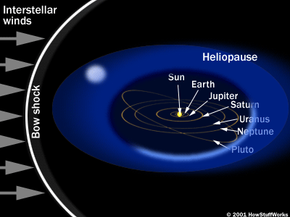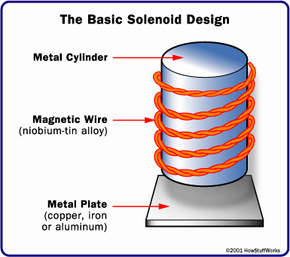The U.S. Department of Energy also is working on plans for a nuclear space reactor for NASA. Goodwin believes that this reactor could be used to power the electromagnetic-propulsion system. The DOE is working to secure funding from NASA, and a 300-kilowatt reactor could be ready by 2006. The propulsion system would be configured to convert the thermal power generated by the reactor into electric power.
"For deep space, Mars and beyond, you pretty much need to go nuclear if you are going to move any mass," Goodwin said.
The reactor will generate power through the process of induced nuclear fission, which generates energy by splitting atoms (such as uranium-235 atoms). When a single atom splits, it releases large amounts of heat and gamma radiation. One pound (0.45 kg) of highly enriched uranium, like that used to power a nuclear submarine or nuclear aircraft carrier, is equal to about 1 million gallons (3.8 million liters) of gasoline. One pound of uranium is only about the size of a baseball, so it could power a spacecraft for long periods of time without taking up much room on it. This kind of nuclear-powered, electromagnetically propelled spacecraft would be able to traverse incredibly large distances.
Thermal energy from a nuclear reactor could be converted into electricity to power the spacecraft.
"You couldn't make it to the nearest star, but you could look at missions to the heliopause," Goodwin said. "If it worked extremely well, it could hit speeds of a fraction of 1 percent of the speed of light. Even at that, it would take hundreds of years to reach the nearest star, which is still impractical."
The heliopause is the point at which the solar wind from the sun meets the interstellar solar wind created by the other stars. It is located about 200 astronomical units (AU) from the sun (the exact location of the heliopause is unknown). One AU is equal to the average distance from the sun to the Earth, or about 93 million miles (150 million km). For comparison, Pluto is 39.53 AU from the sun.
In order to move people, a much larger device would have to be built, but the 1-foot diameter, 3-foot-tall electromagnetic could push small, unmanned spacecraft like an interstellar probe to very far distances. The system is very efficient, according to Goodwin, and it puts a lot of power through a superconductor. The question is whether scientists can convert that power to propulsion without destroying the magnet. The rapid vibration would likely bring the magnet to the edge of its strength.
Skeptics of such a system say that all Goodwin will accomplish is to vibrate the magnet very rapidly, but it won't go anywhere. Goodwin admits that there's no evidence yet that his propulsion system will work. "It is highly speculative, and on my most wildly optimistic days, I think there's one chance in 10 that it might work," said Goodwin. Of course, 100 years ago, people believed we had even less of a chance of ever getting to space at all.

